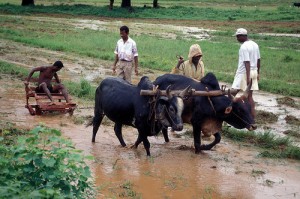Did Gender Inequality Start With the Plow?
 Photo: IRRI Images
Photo: IRRI ImagesFrom a pair of Harvard economists, Alberto Alesina and Nathan Nunn, and a UCLA business school professor, Paola Giuliano, comes this working paper (Abstract here and below; full version here) that tests the hypothesis that current gender role differences can be traced to shifting methods of agriculture, particularly the introduction of the plow, which required significant upper body strength, grip strength, and burst of power that favored men over women.
This paper seeks to better understand the historical origins of current differences in norms and beliefs about the appropriate role of women in society. We test the hypothesis that traditional agricultural practices influenced the historical gender division of labor and the evolution and persistence of gender norms. We find that, consistent with existing hypotheses, the descendants of societies that traditionally practiced plough agriculture, today have lower rates of female participation in the workplace, in politics, and in entrepreneurial activities, as well as a greater prevalence of attitudes favoring gender inequality. We identify the causal impact of traditional plough use by exploiting variation in the historical geo-climatic suitability of the environment for growing crops that differentially benefited from the adoption of the plough. Our IV estimates, based on this variation, support the findings from OLS. To isolate the importance of cultural transmission as a mechanism, we examine female labor force participation of second-generation immigrants living within the US.
A couple highlights:
- We find a strong and robust negative relationship between historical plough-use and unequal gender roles today. Traditional plough-use is positively correlated with attitudes reflecting gender inequality and negatively correlated with female labor force participation, female firm ownership, and female participation in politics.
- We find that women from cultures that historically used the plough have lower rates of labor force participation in the US. This provides evidence that part of the importance of the plough arises through its impact on internal beliefs and values.

Comments